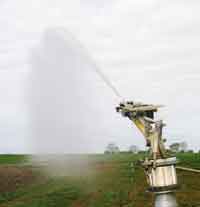Plan ahead for water shortages

Last week’s report by RASE warned of water shortages for the coming decades. Philip Case looks at how growers can prepare for climate change
The first six months of this year were the driest in decades for some parts of Britain – and the north-west had its driest five months since 1929.
And it’s not just summer, rainfall figures for March to May in the last five years from Rothamsted Research show that the UK is getting around two-thirds of its average rainfall over the 30-year long-term average.
ADAS believes it could be a taste of things to come with climate change when the UK is hit by longer, drier summers putting pressure on water resources. The Royal Agricultural Society of England report, carried out by scientists at the University of Reading, agrees, predicting a 20% reduction in river flow by the 2020s and 40% by the 2050s.
Ruth Kendal, farm resource management consultant at ADAS, urges growers to prepare for future shortages. Carrying out a water audit is a good starting point, as it can illustrate water usage and point to possible savings.
Options include rainwater harvesting, harnessing grey water sources and sinking boreholes that do not affect the local environmental balance. Eliminating leaks, using more efficient practices like irrigation scheduling, or reusing water can also help reduce water usage, Ms Kendal adds.
Larger farms could consider building water storage reservoirs, which in some parts of the country can receive funding, such as the Rural Development Programme for England.
Agronomist Steve Cook, of Hampshire independent agronomists Crop Advisors, says that prolonged dry springs followed by a wet August and harvest have become commonplace in the south over the past four years. This has already prompted him to change his recommendations, for wheat in particular.
“Rusts are becoming more important, and if we have these dry spells, septoria becomes less of an issue.”
In wheat, wetter conditions later in the season means growers are placing less emphasis on T2 and instead hitting disease hard at T3.
The timing of T3 applications is two weeks earlier, now at GS59-61 when previously it was GS71+ for best protection against fusarium. “Last season, we did cut back at T2,” says Mr Cook.
However, he says applications at T2 should still be made as the gap between T1 and T3 would be too long and leave leaf 2 exposed.
Early maturing wheats, such as Cordiale and Grafton, are becoming more popular due to the late wet weather and key Group 1 wheat Solstice has been performing well in drought situations, he adds.
He says spring cropping is generally becoming less reliable, but he warns that dropping these crops from rotations will only encourage blackgrass and bromes.
“The reliability of spring cropping is lower on more drought-prone soils,” he notes. Spring oilseed rape can be unreliable, but the use of sewage sludge can increase prospects of good results, he says.
Earlier sowing of spring beans or peas can improve consistency, provided soil conditions are not compromised. Spring linseed and oilseed rape both need to be able to get up and go quickly, he says.
Mark Tucker, head of agronomy at Yara UK, says that nitrogen must be in the top 30cm of soil to ensure that maximum early growth is achieved before the onset of drought.
Increasing root growth through applications of early spring fertiliser will help the crop search out moisture and nutrients, delaying the onset of associated stress.
In drought prone soils, nutrient availability can suffer, says Mr Tucker. “Phosphate and potash are essential nutrients, the latter being especially important in water regulation of the plant,” he says.
Moving P and K applications from autumn to early spring can increase yields in a dry spring.
In the dry spring of 2010, yield responses of between 0.5 and 1t/ha were found for spring applied phosphate on soils with an index of 2 in a Yara trial, managed by Envirofield, in East Yorkshire.

